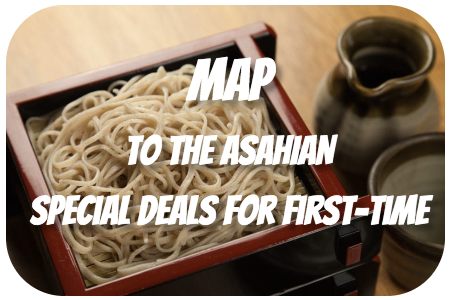‘Everything Freshly Prepared’
This simple yet uncompromising policy has never changed since we first opened our doors.
Asahian in Numabukuro is a small sobaya (soba shop), a typical and time-honored ‘neighborhood’ restaurant.
Founded in 1924, Asahian is now run by its 3rd and 4th generation masters.
The interior is a traditional sobaya-style that has both Japanese zashiki (low tables on tatami mat, where you sit on your knees), as well as tables and chairs. Whether on your own or with a group, we’re certain you’ll find Asahian cozy and welcoming.
Water
Our water, ‘hakuryu gongensui’, is a spring water sourced from our local shrine, Arai-Yakushi. The soft water is full of minerals, and has a clear and mild taste that helps bring out the full flavor of our ingredients.
Soba (thin buckwheat noodles)
The Sobako (buckwheat flour) we use is ‘Yamizo buckwheat flour,’ harvested by our contracted farmers in Nakagawa-machi, Tochigi Pref. We also use sobako from Hokkaido when in season.
Udon (thick flour noodles)
Using the finest udon flour and natural sea salt produced exclusively for noodles, Asahian’s udon has a smooth texture with perfect chewiness.
Changing the amount of water added to the dough depending on the climate, the process of udon making takes two days, and involves strenuous kneading, with a short rest in-between, followed by long resting of the dough after kneading—all to achieve the distinctive texture.
Dashi (soup stock)
To create our dashi, we use only the finest makombu (seaweed) from Hokkaido, and katsuobushi (dried bonito) from Makurazaki in Kogoshima, famous for its production of exquisite katsuobushi. Our water helps bring out the full flavor of these ingredients.
Kaeshi (sweetened soy sauce)
We use two types of a variety of soy sauce made exclusively for soba, and two different kinds of sugar, changing their combination and amount depending on the purpose and time of year. The sauce is matured for three months before use.
Tsuyu (sauce for soba)
Tsuyu is made up of kaeshi and dashi. Its ratio and combination of ingredients differs depending on its purpose.
For example, moritsuyu (tsuyu for mori-soba, a dipping soba) uses fragrant honbushi (the best katsuobushi) as a base, infused with sweet and rich sababushi (dried mackerel flakes) and soudabushi, a katsuobushi with much stronger flavor, to deliver a fragrant and clear-tasting tsuyu.
For kaketsuyu (tsuyu for noodle soup), honbushi and soudabushi are added to sababushi-based dashi, to bring out a rich flavor that customers enjoy savoring to the last drop.
Tendon
You may think that Tendon, or tempura served on a bowl of rice, is all about the tempura. However, it is said that the tare (sauce) is what really determines the quality of the tendon. Many traditional restaurants have their own original tare, and the recipe is often a tightly kept secret.
Asahian’s tare remains true to the original since our establishment—it must be heated every day to stay in the best condition at all times. Throughout even the war years, our predecessor made sure to heat it regularly. Our tare is a fruit of our devotion and its very well-balanced flavor says it all; neither too sweet nor too salty, it has a rich and mild taste, yet with a light touch.
Enjoy the fine combination of freshly prepared tempura, rice and our special tare.
Homemade Tsukemono (pickles)
Asahian’s nukadoko (salted rice bran) is looked after carefully by our okami (the lady of the house) to maintain the subtle balance of umami (tastiness) and sourness in our pickles. Pickling time is carefully controlled depending on the weather and change of season to ensure the pickles are at their best at all times.
Nakagawa-machi, Tochigi Prefecture
Yamizo is a green, mountainous district located in the northeastern provinces of Tochigi Pref. (it is also the hometown of our okami).
Benefiting from its fertile land and water from the Nakagawa, one of the clearest rivers in Japan, Yamizo is known for the production of Yamizo soba (buckwheat), rich in aroma and flavor.
The bountiful nature of Yamizo offers seasonal vegetation as well; edible wild plants and bamboo shoots are found in the spring; in summer vegetables are harvested in abundance, and come autumn people forage for mushrooms. You can find these gifts from nature in many of our dishes.
03-3386-5855
3-7-11 Numabukuro, Nakano-ku, Tokyo
Business Hours
Lunch: 11.40am – 3pm (Last order: 2:45pm)
Dinner: 5.30pm – 8pm (Last order: 7:45pm)
Closed on Tuesdays and two monday a month.


